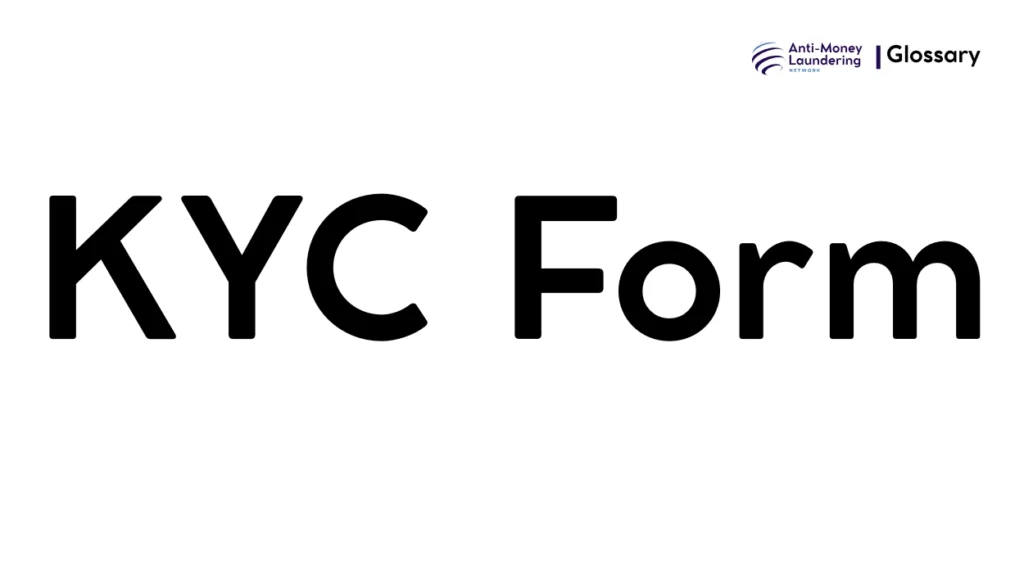Definition
A KYC Form (Know Your Customer Form) is a foundational document used by financial institutions and regulated entities to collect and verify customer identity information as part of the anti-money laundering (AML) framework. It is a formal questionnaire and information-gathering tool designed to establish the customer’s true identity, assess risk factors, and comply with AML regulatory requirements.
Purpose and Regulatory Basis
The KYC Form plays a critical role within AML efforts, helping institutions prevent financial crimes such as money laundering, terrorist financing, fraud, and identity theft. Regulatory frameworks mandate the collection of KYC information to promote transparency and accountability in financial transactions. Key regulations mandating KYC include:
- The Financial Action Task Force (FATF) Recommendations, which set global AML standards.
- The USA PATRIOT Act, which enforces stringent customer identification for financial institutions in the United States.
- The European Union’s Anti-Money Laundering Directives (AMLD), emphasizing customer verification across member countries.
These regulations require institutions to conduct customer due diligence (CDD) by obtaining and verifying identification data before establishing a business relationship.
When and How it Applies
KYC Forms are primarily used during the customer onboarding process, such as when opening bank accounts, investment services, insurance policies, or other financial products. The form must be completed before the institution can legally accept the customer. Additionally, KYC processes may be triggered by:
- Significant transactions or changes in customer behavior.
- Periodic reviews of existing customer profiles.
- Updates to regulatory requirements.
In practice, completing a KYC Form involves submitting personal details, identification documents, proof of address, and sometimes financial background information.
Types or Variants
KYC Forms vary based on institution types and risk profiles. Common variants include:
- Standard KYC Forms: For regular customers with straightforward risk profiles.
- Enhanced KYC Forms: For high-risk customers or politically exposed persons (PEPs), requiring more detailed information and scrutiny.
- Digital KYC (eKYC): Leveraging digital identity verification technologies such as biometrics and document scanning to streamline the process.
Procedures and Implementation
To implement KYC compliance effectively, institutions follow these steps:
- Customer Identification: Collect name, date of birth, national ID numbers, and other identifiers using the KYC Form.
- Verification: Use official documents (passports, licenses), biometric checks, or digital verification systems to authenticate the customer’s identity.
- Risk Assessment: Evaluate customer risk based on geographic location, occupation, transaction patterns, and PEP status.
- Record Keeping: Maintain copies of KYC Forms and verification evidence securely for regulatory inspection.
- Ongoing Monitoring: Periodically update customer profiles and monitor transactions for suspicious activity.
Institutions often deploy automated AML/KYC software platforms to integrate these steps efficiently and reduce human error.
Impact on Customers/Clients
From a customer’s perspective, the KYC Form process involves providing detailed personal information and supporting documents, which may be perceived as intrusive but serve to protect both parties from fraud and financial crime. Customers have rights regarding data privacy and must be informed about how their data is used and stored. They are also subject to certain restrictions if identified as high-risk or involved in suspicious activities.
Duration, Review, and Resolution
KYC Forms are valid for varying durations depending on jurisdiction and risk assessment. Typically, customer information is reviewed:
- At account opening.
- Periodically (e.g., annually).
- Upon material changes to customer status.
If discrepancies or suspicious activities are found during reviews, institutions may require customers to update their KYC Forms or, in some cases, terminate relationships.
Reporting and Compliance Duties
Institutions must:
- Ensure all KYC Forms are accurately completed and verified.
- Keep detailed records for prescribed retention periods (commonly five years).
- Report suspicious transactions or customers identified through KYC procedures to designated authorities.
- Train staff on KYC obligations and update policies as regulations evolve.
Failure to comply can lead to regulatory penalties, fines, or reputational damage.
Related AML Terms
KYC Forms connect closely with several AML concepts:
- Customer Due Diligence (CDD): The process of verifying customer identity and risk.
- Enhanced Due Diligence (EDD): Additional scrutiny for higher risk customers.
- Transaction Monitoring: Ongoing review of customer transactions for suspicious patterns.
- Politically Exposed Persons (PEP) Screening: Identifying customers with high public profiles.
Challenges and Best Practices
Common challenges in KYC implementation include keeping data up-to-date, balancing thoroughness with customer experience, and managing false positives in risk detection. Best practices involve:
- Leveraging digital verification technologies to speed onboarding.
- Implementing a risk-based approach prioritizing resources on higher-risk profiles.
- Regular staff training for compliance awareness.
- Maintaining transparent communication with customers regarding data use.
Recent Developments
Recent trends in KYC include:
- Increased adoption of eKYC methods using AI, biometrics, and facial recognition.
- Regulatory moves toward standardized digital identity frameworks.
- Greater emphasis on data privacy and cybersecurity in KYC data management.
- Automation and integration with blockchain and decentralized identity systems for enhanced security and efficiency.
The KYC Form is a critical instrument in the AML toolkit, enabling financial institutions to verify customer identities, assess risk, and comply with regulatory mandates worldwide. Properly implemented, it helps protect the financial system from abuse and safeguards both institutions and their customers against financial crime.

